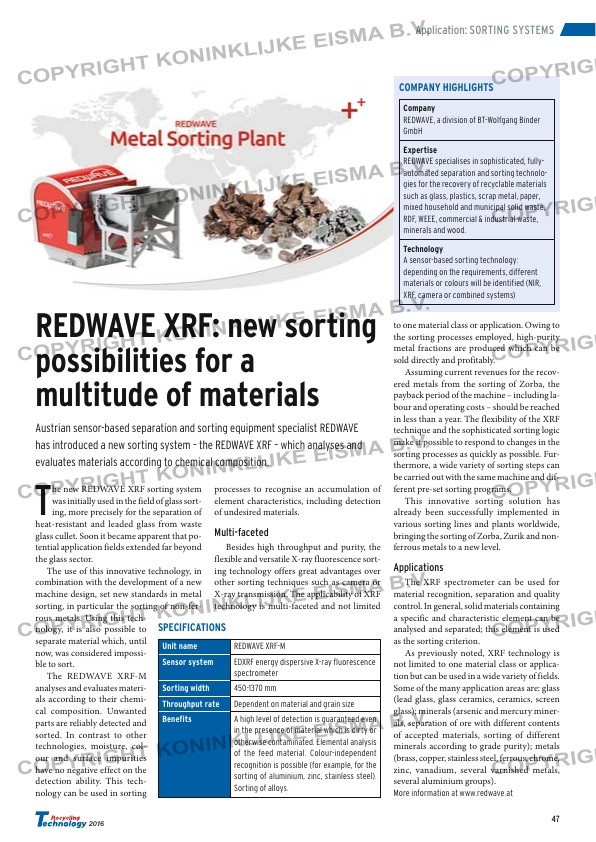Page 67 from: Recycling Technology 2016

47
2016
Application: SORTING SYSTEMS
REDWAVE XRF: new sorting
possibilities for a
multitude of materials
Austrian sensor-based separation and sorting equipment specialist REDWAVE
has introduced a new sorting system – the REDWAVE XRF – which analyses and
evaluates materials according to chemical composition.
T
he new REDWAVE XRF sorting system
was initially used in the field of glass sort-
ing, more precisely for the separation of
heat-resistant and leaded glass from waste
glass cullet. Soon it became apparent that po-
tential application fields extended far beyond
the glass sector.
The use of this innovative technology, in
combination with the development of a new
machine design, set new standards in metal
sorting, in particular the sorting of non-fer-
rous metals. Using this tech-
nology, it is also possible to
separate material which, until
now, was considered impossi-
ble to sort.
The REDWAVE XRF-M
analyses and evaluates materi-
als according to their chemi-
cal composition. Unwanted
parts are reliably detected and
sorted. In contrast to other
technologies, moisture, col-
our and surface impurities
have no negative effect on the
detection ability. This tech-
nology can be used in sorting
processes to recognise an accumulation of
element characteristics, including detection
of undesired materials.
Multi-faceted
Besides high throughput and purity, the
flexible and versatile X-ray fluorescence sort-
ing technology offers great advantages over
other sorting techniques such as camera or
X-ray transmission. The applicability of XRF
technology is multi-faceted and not limited
to one material class or application. Owing to
the sorting processes employed, high-purity
metal fractions are produced which can be
sold directly and profitably.
Assuming current revenues for the recov-
ered metals from the sorting of Zorba, the
payback period of the machine – including la-
bour and operating costs – should be reached
in less than a year. The flexibility of the XRF
technique and the sophisticated sorting logic
make it possible to respond to changes in the
sorting processes as quickly as possible. Fur-
thermore, a wide variety of sorting steps can
be carried out with the same machine and dif-
ferent pre-set sorting programs.
This innovative sorting solution has
already been successfully implemented in
various sorting lines and plants worldwide,
bringing the sorting of Zorba, Zurik and non-
ferrous metals to a new level.
Applications
The XRF spectrometer can be used for
material recognition, separation and quality
control. In general, solid materials containing
a specific and characteristic element can be
analysed and separated; this element is used
as the sorting criterion.
As previously noted, XRF technology is
not limited to one material class or applica-
tion but can be used in a wide variety of fields.
Some of the many application areas are: glass
(lead glass, glass ceramics, ceramics, screen
glass); minerals (arsenic and mercury miner-
als, separation of ore with different contents
of accepted materials, sorting of different
minerals according to grade purity); metals
(brass, copper, stainless steel, ferrous, chrome,
zinc, vanadium, several varnished metals,
several aluminium groups).
More information at www.redwave.at
COMPANY HIGHLIGHTS
Company
REDWAVE, a division of BT-Wolfgang Binder
GmbH
Expertise
REDWAVE specialises in sophisticated, fully-
automated separation and sorting technolo-
gies for the recovery of recyclable materials
such as glass, plastics, scrap metal, paper,
mixed household and municipal solid waste,
RDF, WEEE, commercial & industrial waste,
minerals and wood.
Technology
A sensor-based sorting technology:
depending on the requirements, different
materials or colours will be identified (NIR,
XRF, camera or combined systems)
SPECIFICATIONS
Unit name REDWAVE XRF-M
Sensor system EDXRF energy dispersive X-ray fluorescence
spectrometer
Sorting width 450-1370 mm
Throughput rate Dependent on material and grain size
Benefits A high level of detection is guaranteed even
in the presence of material which is dirty or
otherwise contaminated. Elemental analysis
of the feed material. Colour-independent
recognition is possible (for example, for the
sorting of aluminium, zinc, stainless steel).
Sorting of alloys.



